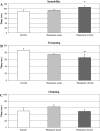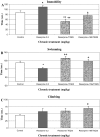Antidepressant-like effect of tetrahydroisoquinoline amines in the animal model of depressive disorder induced by repeated administration of a low dose of reserpine: behavioral and neurochemical studies in the rat
- PMID: 24407488
- PMCID: PMC4035545
- DOI: 10.1007/s12640-013-9454-8
Antidepressant-like effect of tetrahydroisoquinoline amines in the animal model of depressive disorder induced by repeated administration of a low dose of reserpine: behavioral and neurochemical studies in the rat
Abstract
Animal models are widely used to study antidepressant-like effect in rodents. However, it should be mentioned that pharmacological models do not always take into account the complexity of the disease process. In the present paper, we demonstrated that repeated but not acute treatment with a low dose of reserpine (0.2 mg/kg i.p.) led to a pharmacological model of depression which was based on its inhibitory effect on the vesicular monoamine transporter 2, and monoamines depleting action in the brain. In fact, we observed that chronic treatment with a low dose of reserpine induced a distinct depressive-like behavior in the forced swim test (FST), and additionally, it produced a significant decrease in the level of dopamine, noradrenaline, and serotonin in the brain structures. 1,2,3,4-Tetrahydroisoquinoline (TIQ) and its close methyl derivative, 1-methyl-1,2,3,4-tetrahydroisoquinoline (1MeTIQ) are exo/endogenous amines present naturally in the mammalian brain which demonstrated a significant antidepressant-like effect in the FST and the reserpine model of depression in the rat. Both compounds, TIQ and 1MeTIQ, administered chronically in a dose of 25 mg/kg (i.p.) together with reserpine completely antagonized reserpine-produced depression as assessed by the immobility time and swimming time. Biochemical data were in agreement with behavioral experiments and demonstrated that chronic treatment with a low dose of reserpine in contrast to acute administration produced a significant depression of monoamines in the brain structures and impaired their metabolism. These neurochemical effects obtained after repeated reserpine (0.2 mg/kg i.p.) in the brain structures were completely antagonized by joint TIQ or 1MeTIQ (25 mg/kg i.p.) administration with chronic reserpine. A possible molecular mechanism of action of TIQ and 1MeTIQ responsible for their antidepressant action is discussed. On the basis of the presented behavioral and biochemical studies, we suggest that both compounds may be effective for the therapy of depression in clinic as new antidepressants which, when administered peripherally easily penetrate the blood-brain barrier, and as endogenous compounds may not have adverse side effects.
Figures




References
-
- Antkiewicz-Michaluk L, Michaluk J, Mokrosz M, Romańska I, Lorenc-Koci E, Otha S, Vetulani J. Different action on dopamine catabolic pathways of two endogenous 1,2,3,4-tetrahydroisoquinolines with similar antidopaminergic properties. J Neurochem. 2001;78:100–108. doi: 10.1046/j.1471-4159.2001.00391.x. - DOI - PubMed
-
- Antkiewicz-Michaluk L, Lazarewicz JW, Patsenka A, Kajta M, Zieminska E, Salinska E, Wasik A, Golembiowska K, Vetulani J. The mechanism of 1,2,3,4-tetrahydroisoquinolines neuroprotection: the importance of free radicals scavenging properties and inhibition of glutamate-induced excitotoxicity. J Neurochem. 2006;97:846–856. doi: 10.1111/j.1471-4159.2006.03756.x. - DOI - PubMed
Publication types
MeSH terms
Substances
LinkOut - more resources
Full Text Sources
Other Literature Sources
Medical
Miscellaneous

